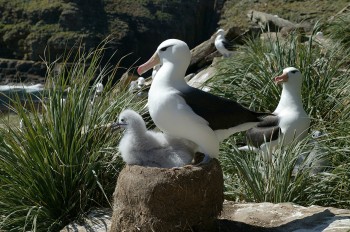Through the South African National Antarctic Programme (SANAP) the Marine Apex Predator Research Unit (MAPRU); Coastal and Marine Research Institute, Nelson Mandela University in collaboration with the FitzPatrick Institute of Ornithology, University of Cape Town, is offering two full-time study opportunities (1 PhD [2019-2021] and 1 MSc [2019-2020]) starting in early 2019.
The two opportunities fall within the project ‘Small Procellariiformes as indicators of ecosystem changes and plastic pollution’ led by Dr Maëlle Connan (MAPRU) and Prof. Peter Ryan (FitzPatrick Institute). This project intends to use burrowing seabirds, including three species of ACAP-listed Procellaria petrels, breeding on the Prince Edward Islands, the Tristan da Cunha Archipelago and possibly Antarctica as indicators of the health and status of the Southern Ocean ecosystem. One aspect of the project focuses on the trophic ecology of these species that will be determined using direct (identification of prey remains) and indirect (stable isotopes, lipids) approaches. The second aspect uses the birds as biological samplers to investigate the extent of plastic pollution in the Southern Ocean. Micro and macro-plastic pollution loads will be estimated mostly from seabird stomach contents and pellets. The combination of contemporary data with historical works will inform on the impact of global change on marine ecosystems as well as temporal trends in pollution loads.
Both candidates will be expected to work on both aspects of the project (trophic ecology and pollution loads). The PhD candidate will be expected to work at the community level whereas the MSc candidate will work at the species level. There is some flexibility and the two projects can be tailored to fit the interests of the suitable candidates.
The two projects will be co-supervised by Prof P. Ryan and Dr M. Connan. The candidates will be based at Nelson Mandela University in Part Elizabeth with potential trips to the University of Cape Town. Overwintering personnel are currently collecting samples on Marion and Gough Islands. Fieldwork cannot be guaranteed but the successful candidates may conduct part of the fieldwork on one of the islands.
The successful applicants will be awarded an MSc bursary (South African Rands R70 000 per year) or a PhD bursary (South African 100 000 per year) and may apply for an additional Nelson Mandela University Research Bursary. All other project related costs have also been secured.

White-chinned Petrels, photograph by Ben Phalan
Applications should include:
- A covering letter explaining the candidate suitability and interest for the project;
- A comprehensive CV, including contact details (e-mail addresses and telephone numbers) of at least three referees;
- Certified copies of academic records and ID; and
- A pdf copy of the BSc Honours (MSc project) or MSc thesis (PhD project).
Note: South African applicants will receive priority. Preference will be given to previously disadvantaged individuals who are particularly encouraged to apply. If you have not been contacted by 31 January, please assume that your application was unsuccessful. The closing date is 25 January 2019.
Queries oand applications should be directed to Prof. Peter Ryan (This email address is being protected from spambots. You need JavaScript enabled to view it.) and Dr Maëlle Connan (This email address is being protected from spambots. You need JavaScript enabled to view it.).
With thanks to Maëlle Connan.
John Cooper, ACAP Information Officer, 11 January 2019


 English
English  Français
Français  Español
Español 


